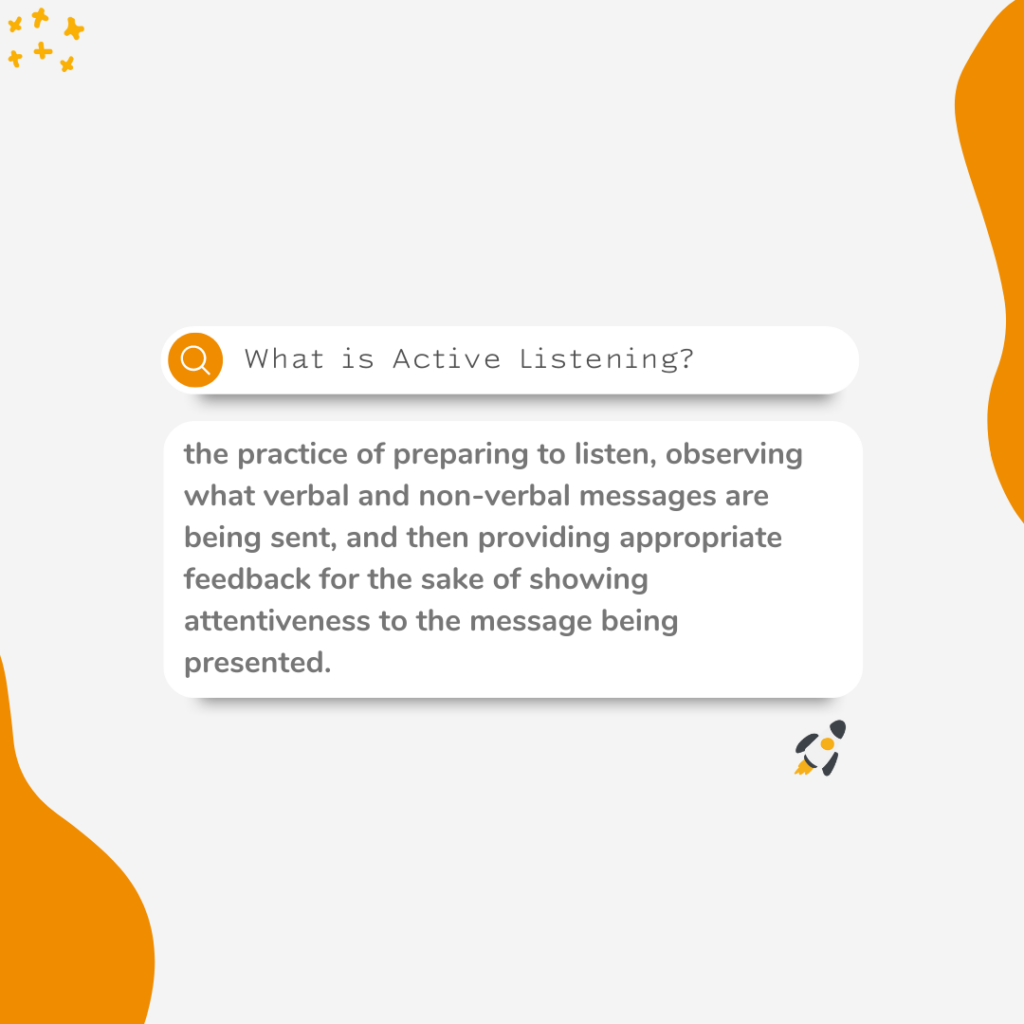A Manager’s Guide to Active Listening
Posted by Trakstar • May 1, 2023 • 7 min read
Active listening is a skill that many managers think they have, but they don’t. One of the number one reasons employees leave is because they don’t feel heard or understood by their managers. Active listening can fix that – and a host of other communication and leadership problems.
One essential skill that every great leader must have is the ability to turn off from the rest of the world and participate in active listening when their employees are talking. Effective listening means hearing your employees and internalizing what they say, reading their body language, and thinking about the person as they speak.
It’s not just about hearing what a person says when they talk to you but truly understanding their perspective and needs as an employee and as a person. Good listening skills are a start, but you need other things. Passive listening can look like good listening, but it cannot look like active listening. If you claim “good communication skills,” you need to know the difference.
By practicing active listening, managers can build better employee relationships, increase productivity, and create a positive work environment. Effective communication is the backbone of a strong company culture, so much so that it is one of the most critical soft skills taught in new manager training!
What is Active Listening?
Active listening is a communication technique that involves giving your full attention to the speaker and showing them that you understand what they’re saying. It’s about hearing words and understanding the speaker’s feelings, thoughts, and intentions. It also means that you can respond in a way that is productive, empathetic, and understanding. Carl Rogers breaks down the psychology behind it here.
To be an active listener, you must focus on the conversation without distractions. This means avoiding multitasking or interrupting the speaker with your thoughts or opinions. Instead, let them finish their sentences before responding. This isn’t easy! Active listening techniques can take years to perfect. Taking good listeners and making them active is challenging, but it’s worth it. To make someone a better listener, you have to give them practical experience, teach them active listening skills, learn about nonverbal cues, practice conflict resolution, and so much more.
Most importantly, active listening requires empathy – putting yourself in someone else’s shoes and seeing things from their perspective. This is a complex but essential skill to learn. Doing this lets you better understand your employees’ emotions and motivations behind what they say. This builds a stronger relationship between managers and employees, improves internal communication strategies, and promotes engagement.
It’s important to note that active listening is not passive agreement or acceptance of everything someone says. It may require you to push back, ask relevant questions, engage in nonverbal communication, and be a good listener rather than a debater. Even with you disagree with what is being said, a manager must know how to acknowledge their point of view. When appropriate, another key skill is sharing your perspective on the topic with an understanding of where that other person stands.
In short, active listening involves paying full attention to someone during a conversation by focusing on what they say without interruption or distraction. It also requires empathy and respect for different viewpoints while sharing one’s ideas honestly.

The Benefits of Active Listening in the Workplace
Active listening is a skill that can benefit everyone, regardless of their profession or personal life – it builds stronger relationships between people, which is something many of us struggle with. By actively listening to others, you show them respect and create an environment where they feel heard and understood. This can lead to stronger relationships, better communication, and improved problem-solving. This is one of those soft skills people look for when determining succession or management capabilities.
Active Listening Builds Trust
One significant benefit of active listening for managers is that it helps build trust between individuals, teams, and the entire company. When employees feel like they are being truly listened to and understood, they are more likely to open up and share their thoughts and feelings honestly. This can help organizations reach their goals, resolve conflict, reach an understanding, and become effective listeners. This should be a soft skill for every single position on your team – whether they are a manager or not. Understanding, nonverbal communication, active listening, communication strategies, and the ability to question are all part of being an employee in today’s world.
Increase Trust By Building Good Listeners
Another benefit of active listening is that it promotes more transparent communication by reducing misunderstandings. By fully engaging with what someone has to say, you better understand their perspective, allowing for more effective problem-solving. If you’re a manager who has a team with conflict, it may be because people aren’t actively listening to each other.
Effective Communication Fosters Empathy
Active listening also shows empathy toward the speaker’s situation. People often just want someone who will listen without judgment or interruption – this gives them space for self-reflection as well as greater confidence in themselves when sharing ideas or concerns in future conversations.

How to Be an Active Listener
Active listening is a skill that can be developed over time with practice. For managers, it starts by practicing one active listening technique at a time. Then, it requires refinement and a true reflection on your skills, feelings, and conversations.
Some of our favorite tips on how to be an active listener include:
- Pay attention: Focus on the person speaking and try not to get distracted by external factors. When you’re having a meeting with your employees, give them your undivided attention.
- Show interest: Use verbal cues such as nodding, saying “uh-huh” or “yes” to show that you’re engaged in the conversation. Nodding, taking notes, and retaining eye contact are also things to practice.
- Repeat what you’ve heard: This shows that you’ve understood what has been said and allows the speaker to clarify any misunderstandings. If you don’t understand, get them to clarify.
- Avoid interrupting: Let the speaker finish their thought before responding so they feel heard. Remember that you can interrupt with more than just your voice. Nonverbal cues such as making a strange facial expression, crossing your arms, or rolling your eyes can all interrupt someone.
- Ask open-ended questions: These encourage deeper discussion and give the speaker more space to express themselves. Practice asking these questions and even have some written down before going into a one-on-one with your employees.
- Summarize at intervals: Paraphrase what you’ve heard back to them so they know you’re actively listening. This can help you gain insight into their thought patterns as well.
By implementing these simple steps into your communication style, you’ll be able to listen more effectively and create a stronger connection with your employees.
Want to get some open-ended questions to ask your employees? Click here to download 250+!
Active Listening in the Workplace
Active listening in the workplace is an essential communication skill that managers should possess. It involves listening to what others say without interrupting, judging, or assuming. Active listeners also use open-ended questions and body language to clarify understanding.
Incorporating active listening can have several benefits, such as fostering better relationships among colleagues and improving team dynamics. Employees who feel heard and valued are more engaged and motivated at work.
Moreover, active listening can help prevent misunderstandings leading to conflicts or mistakes. By being attentive to details and asking follow-up questions when necessary, managers can ensure that instructions are clear and understood by everyone involved.
To practice active listening in the workplace, managers can start by setting aside distractions like phones or laptops during conversations with their employees. They should also try to maintain eye contact, nod occasionally, and provide verbal cues such as “I see” or “Go on.”
Incorporating active listening into your management style is a simple yet powerful way of better transforming your team’s communication dynamic.
To see an active listening example, watch the video below:
Ready to be a Better Partner to Your Employees?
Active listening is a simple yet powerful tool that can significantly impact any organization’s success. By practicing, you can build stronger employee relationships and create a more productive workplace.
Remember that active listening is hearing and understanding words’ meaning and context. It requires patience, empathy, and an open mind. As a manager or leader in your organization, it’s crucial to make active listening part of your daily routine and encourage others to do the same.
Are you ready to be a better partner to your employees? If so, it starts by having software that allows you to have better conversations around performance, goals, and issues facing your workforce. Trakstar Perform can help you there. Click here to schedule a demo today.
Don't Miss Out on More Great HR Articles!
Subscribe to get the latest, greatest HR and Talent Development content straight to your inbox.


